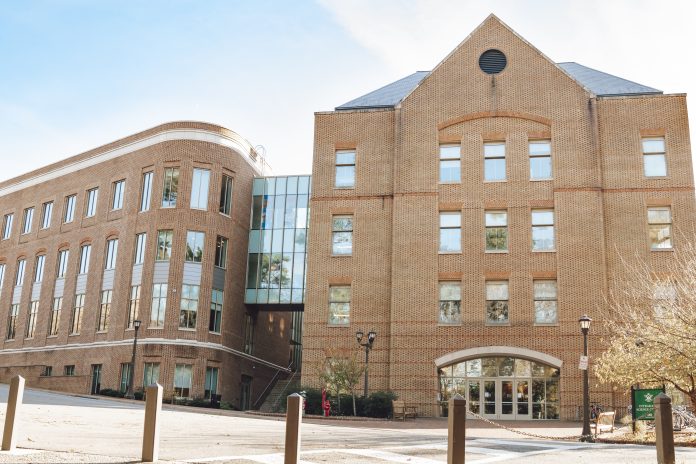Nov. 5, Melissa Checker gave a talk on environmental justice in collaboration with the Institute for Integrative Conservation speaker series. The talk centered around Checker’s book “The Sustainability Myth: Environmental Gentrification and the Politics of Justice.”
“Our mission is to cultivate an inclusive community of creative leaders to deliver innovative solutions to global conservation challenges,” ICC Program Manager Erica Garroutte said.
Before the talk, Checker was praised by Sydney Fuhrig ‘21, who discussed how Checker’s work influenced her own research.
“Dr. Checker’s work on environmental gentrification has actually impacted my research in a profound way,” Fuhrig said. “It influenced my ongoing Honors thesis on urban parks in Richmond, Virginia. She is a true inspiration for environmental advocacy.”
Checker began her talk by discussing the New York Wheel, a planned construction project in New York to create the largest Ferris wheel on Earth. The brainchild of former New York City Mayor Michael Bloomberg, it was intended to boost the economy by creating jobs and increasing tourism. However, the Wheel also drew criticism from residents.
“New Yorkers were worried that people would drive cars there and it would increase traffic,” Checker said. “People who lived extremely close by were unhappy about the lights that would be shining on them all night.”
“Dr. Checker’s work on environmental gentrification has actually impacted my research in a profound way.”
According to Checker, New York Wheel CEO Richard Marin attempted to reassure residents by pointing out that the Wheel would be powered by wind, solar and water-based energy, as well as being lit by LED lights. These reassurances failed to persuade many residents, in large part because the discussion was occurring just weeks after Hurricane Sandy had devastated New York City.
Checker then moved to discuss a nearby area, a five-mile stretch of land referred to by some as an “Industrial Girl’s Gone Wild.”
“Along that strip of land were about 21 industrial properties that were contaminated with some kind of hazardous waste materials,” Checker said. “All of them sat within 70 feet of densely populated residential areas.”
Checker said that the development of a massive ‘sustainable’ infrastructure project directly beside a neighborhood beset with environmental problems is an illustration of the contradictions of sustainability that she focuses on in her research.
Moving on to the broader picture of environmental justice in the United States, Checker presented some statistics on environmental inequity. Notably, the greatest predictor of exposure to pollutants was race, not class. Furthermore, Latino and African-American individuals were exposed to 50% more pollutants than they produced, while white individuals were exposed to 17% less pollutants than they produced.
“If you look at a low-income white neighborhood versus even a middle income African American neighborhood, the African American neighborhood is more likely to host a toxic waste site,” Checker said.
As an explanation for these inequalities Checker pointed to barriers to access to jobs and education, as well as formal and informal methods of segregation.
Checker then moved to discuss the strategic plan for New York (PlaNYC) developed in 2007 by Bloomberg.
“It laid out a sweeping agenda for accommodating a growth in population … while also retaining a commitment to sustainability,” Checker said. “The plan included everything from affordable housing to park access to reducing carbon emissions.”
A large portion of the plan was rezoning neighborhoods to allow for denser housing, which was justified as a way of furthering sustainability. Checker examined this area in her research, terming this combination of environmental improvements with high-end redevelopment “environmental gentrification.” Checker stated that there were three types of environmental gentrification — green gentrification, industrial gentrification and brown gentrification.
“If you look at a low-income white neighborhood versus even a middle income African American neighborhood, the African American neighborhood is more likely to host a toxic waste site.”
“Green gentrification is the use of green amenities like new parks, greenways, all of these greening projects in tandem with redevelopment,” Checker said. “Because a lot of these new parks were predicated on having affluent residents nearby to support them, it was explicit that these things were tied to bringing in more affluent people to live in those areas, so the park distribution ended up being fairly uneven.”
Checker described industrial gentrification as the process by which old centers of manufacturing were remade to be more environmentally friendly.
“It’s a great thing, but the distribution of it really accorded with real estate development,” Checker said.
Similarly, brown gentrification is the cleaning up and repurposing of individual containment sites. Cities incentivize this process by allowing real estate companies to write off the cost of cleaning up the site. Although the idea behind the concept is sound, the issue, according to Checker, was the close involvement of real estate developers in the process. As a result, there was little incentive for companies to develop at a site that was not in an upcoming neighborhood.
“It really jeopardized the environmental health of the people who didn’t happen to be living in gentrifying neighborhoods,” Checker said.
Following her discussion of environmental gentrification, Checker answered questions from the audience. One asked if there was a way forward for environmentalists, given the failures of previous attempts at sustainable development which had been discussed in the presentation. Although Checker said that there was no way to entirely decouple green projects from real estate development due to the fiscal constraints on local governments, it was possible for more equitable distribution to occur through the benefits of development.
Checker concluded this talk with an optimistic note on the continuing growth of the environmental movement, and its reach across communities.
“The environmental justice movement has been pretty well organized and very vocal, taking a stand on all sorts of local levels as well as globally, and I think it’s really had an impact,” Checker said.

